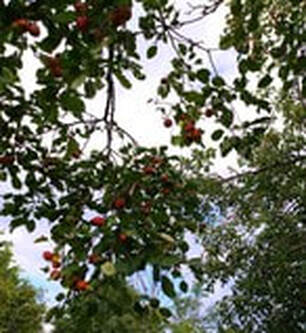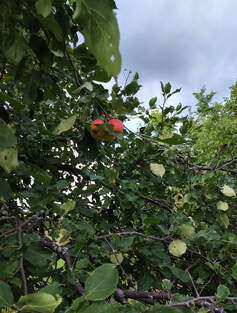|
The only apples truly native to North America are crabapples, sometimes called ‘common apples’. These apples are tiny, tart and often grow in the wild. Old, craggily trees can be found in long abandon orchards on early homesteads. Indigenous People are said to have tended to crabapple trees in ‘forest gardens’. They used all parts of these trees. The tough hard wood made strong tools. The fruit provided food and the bark was used for tea and its medicinal properties to treat many ailments. The acidity of crabapples provides a natural preservative which was beneficial for storage over time. The fruit becomes sweeter as it is stored. The Hudson Bay Company planted crabapple trees near forts to combat scurvy. When settlers arrived, they carried seeds and sometimes even apple tree saplings with them. The first real orchards they established as part of their early agriculture were in the eastern regions of Canada including what is now known as the Eastern Townships. Most of these trees were planted in the late 1800’s. Crabapples were popular for producing cider because of the high level of natural tannins they possessed. As tastes changed, sweeter ‘dessert’ apples became popular and more widely used. Heirloom apple varieties included Golden Russet, Ribston Pippin, Duchess, Snow and Wolf River. It took one third of a bushel of apples to produce a gallon of cider. The apples were washed, cut and ground into a mash of pulp containing the skin and flesh. This mash was traditionally wrapped in straw and then as time passed, in cloth as it was squeezed to extract the juice. The remaining pulp was called ‘pomace’ and would be fed to farm animals as ‘mash’. The first commercial cidery in Canada was established on the Saanich Peninsula in British Columbia in 1928. Today, the vintage apple presses that required lots of manual labour have been replaced by machines with hydraulic power. The pure apple juice that is produced by an apple cider press is pasteurized for commercial consumption. To preserve fresh, raw apple juice, it should be heated to 190 degrees Fahrenheit. It can then be stored in sealed, sterilized bottles to be enjoyed throughout the winter months. The pasteurized juice can also be frozen for use at a later date. The Middleville and District Museum will be using its vintage Apple Press to turn juicy apples into a sweet, liquid treat. Visitors are invited to bring their own containers for a sample. At the event, on Saturday October 8th, 2022, sweet baked, apple treats will be enjoyed by visitors. Recipes, activities and a craft for kids will add to the fun. Come out and enjoy this free, outdoor event at the Museum. Noon – 4 pm. Of course, the Museum will be open to visitors, as well.
0 Comments
Leave a Reply. |
AuthorThis journal is written, researched, and maintained by the volunteers of the Middleville Museum. |




